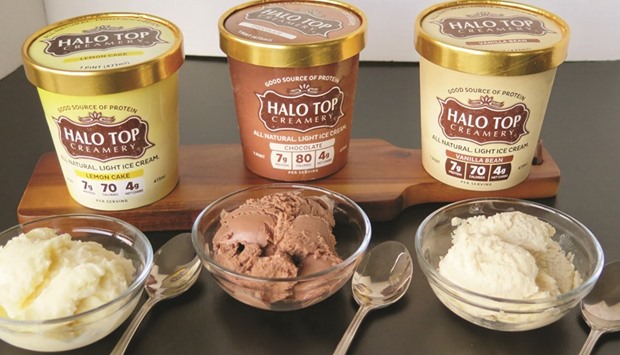For a trek through Big Bend National Park in Texas, professional photographer Jay Kazen brought all the necessities. Tent. Sleeping bag. Canon 5DS. Four pints of Halo Top ice cream.
Since Kazen, 27, first discovered the low-calorie, high-protein treat, he rarely goes a day without some. He buried the pints at the bottom of a cooler packed with dry ice to survive the heat through the 800,000-acre national park.
“I’m kind of addicted,” he said.
Kazen Instagrammed several pictures of himself eating Halo Top in the wilderness, sandwiched between stunning shots of desert landscapes. The shots were so beautiful, they almost looked like an advertisement. The post garnered more than 1,000 likes—including one from the brand. “That’s pretty cool,” he said of the company’s response.
That engagement is no accident. Behind the scenes at Halo Top Creamery, more than a dozen communications and marketing staffers create new digital content, develop the brand’s voice and respond to hundreds of social media posts about ice cream each day.
“It’s our philosophy to reply to anyone and everyone who makes a post about us,” said Ryan Bouton, the company’s director of communications. With more than 700mn users, Instagram has become a platform for hawking everything from corsets to laxatives. While many brands pay influencers to promote their products, Halo Top says it has never paid for a post. Nonetheless, the hashtag “Halo Top” has been used close to 100,000 times, and the company’s account has nearly 400,000 followers. Until recently, it hadn’t spent a dime on traditional advertising—just some targeted digital ads on social media.
Since hitting the shelves in 2012, Los Angeles-based Halo Top has exploded in popularity, with sales increasing 2,500% last year alone, hawking about 17mn pints. (For comparison, Ben & Jerry’s sold more than 150mn pints, according to a Ben & Jerry’s spokeswoman, citing Nielsen data collected last year.)
Halo Top has won taste-test battles and even led one brave soul to eat just the ice cream, and nothing else, for 10 days. It tastes like ice cream, but at around 300 calories a pint, it’s a relatively guilt-free treat, made from erythritol, a calorie-free sugar alcohol, Stevia, milk protein, plant fibre, and egg whites. Most of the brand’s growth has been through word of mouth, particularly among Instagram users in fitness and weight-loss communities. They compare notes on flavours, lobby grocery stores to carry the product, and share leads on where to find the treat, which is often sold out. The product can be tough to find in grocery aisles, and the hunt is part of its allure. Even Whole Foods in New York City’s bustling Union Square only had a half dozen of the company’s 17 flavours in stock during a recent visit. Lemon Cake and Black Cherry are the hardest-to-find flavours, the company said.
Halo Top Instagram is peppered with posts from people showing off their “haul,” a multiple-pint purchase in which some enthusiasts can clear out a store’s stock. Some boast about their quest driving store to store. “Part of it is fun,” said Kyle Lowry, 34, from Tulsa, Okla. “It’s like, when are they going to have it, and what flavours are they going to have?” She and her sister, Kara, use Instagram to document the meals on their Weight Watchers diet. When they discovered Halo Top counted for only a handful of the program’s points, they would head out on excursions just to find pints, often leaving stores empty handed. But on a recent trip to Wal-Mart, Kara came across a freezer packed with the ice cream. Her Instagram post racked up more than 500 likes. “If it’s not at your main grocery store, you have to go out of your way to find it,” Kyle Lowry said.
Halo Top founder Justin Woolverton insists it’s not a marketing ploy. He says stores just didn’t expect customers to buy so many pints at a time, and until recently, the ice cream wasn’t carried by grocers nationwide. The average American eats 22 pounds of ice cream annually, according to the International Dairy Foods Association, which is equivalent to between 22 and 33 pints, depending on how tightly they are packed. That’s roughly two pints per month. Halo Top customers, however, eat much more than that, typically purchasing seven to eight pints at a time, Woolverton said. “People eat it every day, every other day,” he said, citing consumer research. “Literally, the stores aren’t equipped to have space for frozen desserts like ours.” To help with that, the company is creating branded freezers, Woolverton said. The lack of advertising was also a function of distribution: The company didn’t want to make big media purchases if the product wasn’t readily available in all markets. Now that Halo Top is available more or less nationwide, the company has started to buy more-traditional advertising, such as radio spots, podcasts, and billboards. But they expect the buzz to continue in digital communities, as customers banter over their favourite flavours.
“We’d love to say it’s because of our genius marketing,” Woolverton said.
“But I think Halo Top really does tend to sell itself.”

Behind the scenes at Halo Top Creamery, more than a dozen communications and marketing staffers create new digital content, develop the brand’s voice and respond to hundreds of social media posts about ice cream each day.
